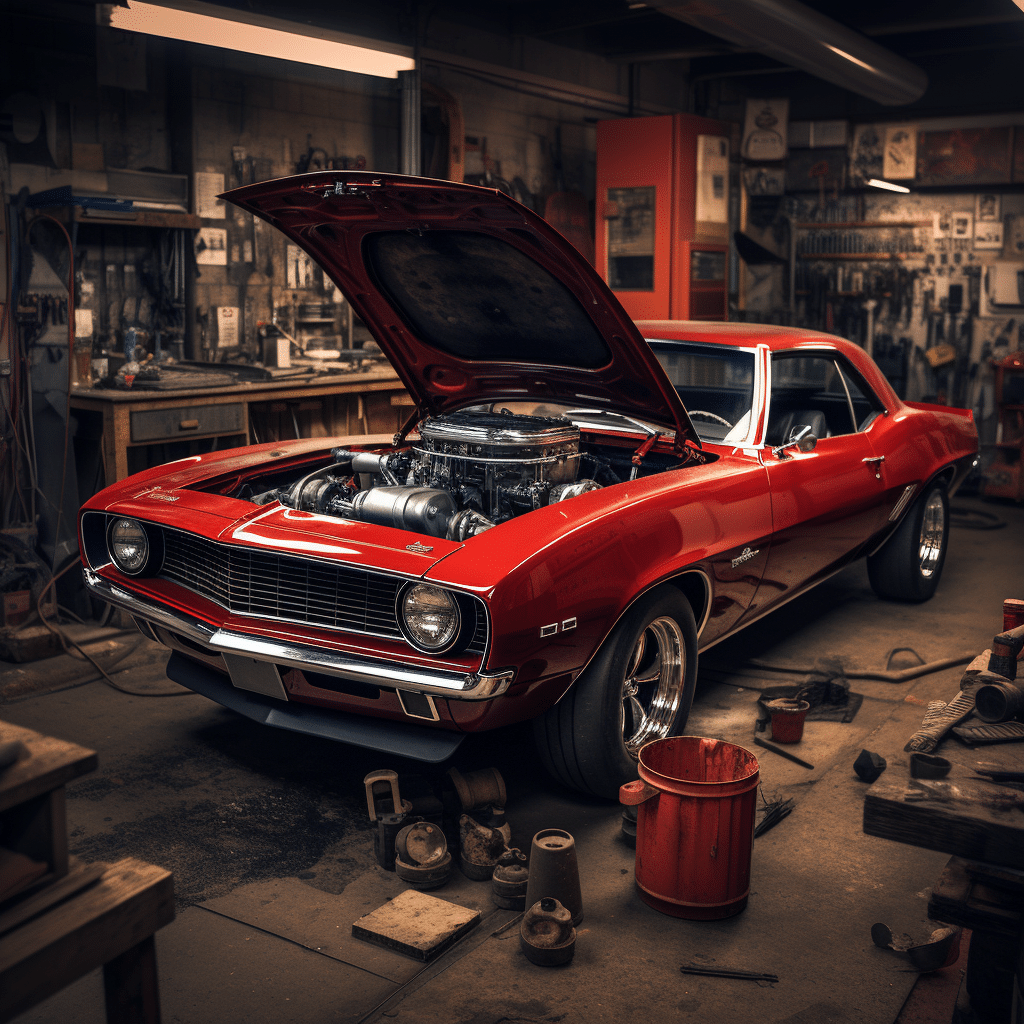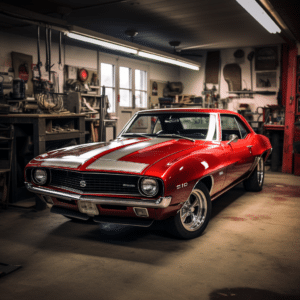
Mastering Muscle Car Restoration: Passion and Precision
Muscle car restoration, Restoring muscle cars is a delicate, intricate process. It needs expertise, attention to detail, and a real passion for automotive classics. The goal? Unite their past with modern technology.
- Step 1: Assess the condition. Look at bodywork, engine, interior, and other components that may need work. This gives important info on the amount of restoration needed.
- Step 2: Dismantle the car. Address each area, like rust removal and body repairs. Do an engine overhaul. Make sure everything is perfect.
- Step 3: Get parts or replicas that match the original specs. Attention to detail is key. Even small discrepancies can lower the value.
- Step 4: Consult resources like manuals, restoration guides, and experts. Get info on period-correct finishes, colors, and other details.
The payoff? According to Classic Cars Journal, restoring a muscle car can increase its value by up to 50%. A passionate pursuit and a smart investment in auto history.
Understanding the Basics of Muscle Cars

Muscle cars boast legendary power and performance. Let’s explore the basics!
For example:
- Make, Model, Engine Size, and Horsepower of the Chevrolet Camaro ZL1 – 6.2 L V8, 650 hp;
- Make, Model, Engine Size, and Horsepower of the Ford Mustang GT – 5.0 L V8, 460 hp;
- Make, Model, Engine Size, and Horsepower of the Dodge Charger SRT Hellcat Widebody – 6.2 L V8, 717 hp.
Not only that, they have awesome acceleration and a head-turning design! Did you know the Dodge Charger SRT Hellcat Widebody is the fastest production sedan in the world?
Source: Car and Driver magazine.
Assessing the Condition of the Muscle Car
Examining a muscle car requires a vigilant eye. As a classic car enthusiast, you must ensure it’s in top shape before you start the restoration process.
- Exterior: Check for rust, dents, or scratches. Observe the body panels, windows, and trim. Note any areas that need repairs or replacement.
- Interior: Check the interior. Ensure all dashboard components are present and functional. Notice any tears or wear on the seats, carpeting, and headliner. Also, check the electrical systems like lights, gauges, and switches.
- Engine: Take a look inside the engine bay. Scan for any oil leaks or loose belts. Inspect the wiring for signs of fraying or damage. Check if any parts are missing or incorrect.
- Undercarriage: Get underneath the car to assess its undercarriage condition. Look for rust or corrosion on the frame and suspension components. Analyze fuel lines and exhaust systems for any leaks or damage.
Also, take into account details specific to each muscle car model.
An often forgotten aspect when assessing a muscle car is its ownership history. Knowing who owned it before can give insights into its care and maintenance. A documented ownership history with regular maintenance records boosts its value.
Assessing the condition of a muscle car is key. This’ll allow you to restore it to its former glory, and maintain its authenticity and value.
Creating a Restoration Plan
Restoring a muscle car needs a plan to make it work. Here’s an easy guide on how to make one:
- Check the car: Have a thorough look at it to find out what needs fixing or replacing. Check engine, body, inside and electrical parts.
- Set budget: See how much you’re willing to spend. Factor in parts, labor and extra costs that may come up.
- Goals: Figure out what level of restoration you want. Is it for a showroom or just for driving?
- Research: Look into the make and model of your car. Join forums, read guides and ask experts for advice.
- Timeline: Set deadlines for each phase. This can keep you motivated and focused.
- Document: Write down all repairs, buys and modifications. This helps if you decide to sell it later.
Plus, talk to pros who can help you.
Pro Tip: Make a checklist of tasks and update it as you go. This stops any steps being missed.
Stripping and Preparing the Car
Gently strip away the exterior components like trim, moldings and bumpers. Carefully remove the interior elements including seats, carpets and dashboard. Then, to protect it from rust, wash it completely and coat it with a rust inhibitor. Don’t rush through this part of the process as it is pivotal to a successful restoration. Each step is important for achieving an ideal base for restoration, so be efficient!
Restoring the Body and Frame
Restoring a muscle car body and frame is intricate. Here’s what to remember:
- Evaluate the damage. Inspect for rust, dents, and structural issues. Take photos and measurements.
- Repair or replace. Small dents can be fixed using paintless dent removal. Bigger ones may need replacement panels. Structural damage might need welding or whole sections of the frame replaced.
- Refinish and protect. Sand down old paint, apply primer, and add layers of paint. Consider adding a clear coat or undercoating to prevent rust.
Alignment is essential too. Misalignment can cause handling issues and tire wear. Use frame jigs and laser measurement systems. Invest time into every detail. Start your restoration journey today!
Rebuilding the Engine and Mechanical Components
Follow this 5-step approach to restore your muscle car:
- Evaluate & Disassemble: Inspect the engine & mechanical parts. Note any worn or damaged parts needing replacement. Disassemble necessary components & mark their location for easy reassembly.
- Clean & Restore: Clean all parts with solvents & brushes. Restore any wearable components, like pistons, bearings, valves or gears with proper machining techniques or replacement.
- Reassemble Precisely: Recombine the parts, paying attention to torque specs & alignment marks. Apply high-quality sealants to prevent leaks.
- Lubricate & Refill Fluids: Lubricate engine block, valve train, transmission gears & differential assembly with manufacturer-recommended oils.
- Test Run & Adjustments: Do a test run to observe performance. Check for any noises or vibrations & monitor temperature levels. Make adjustments to timing, fuel mixture etc. until optimum performance is achieved.
Plus, inspect other components such as brakes, suspension systems, steering mechanisms & electrical wiring to ensure restoration.
Pro Tip: Document each step with notes or pictures. This will help with future maintenance & troubleshooting.
Restoring the Interior
Strip and clean. Start by taking out all the old upholstery, carpets, and trim from the car’s internal space. This will give you a fresh start. Then, clean all surfaces to get rid of any dirt or grime that may have built up.
Repair and replace. Check for any damage or wear. Change any worn-out components like seat cushions, door panels, or dashboard trim. You might also need to mend or replace any electrical parts like gauges or switches.
Upholstery and detailing. Pick high-quality upholstery materials that look like the original design of your muscle car. Whether it’s vinyl, leather, or cloth, make sure it fits nicely and appears genuine. Don’t forget to add finishing touches like new floor mats and headliner.
Final touches. When all the major interior elements are in place, focus on smaller elements like knobs, handles, and emblems. Check if they are clean and working or replace them if necessary. Lastly, give everything a thorough cleaning and polish to make your interior shine.
For an extra touch, search for historical archive images featuring interiors of similar cars in their prime. This will give you valuable understanding of how things were done in the past and help you create an exact representation of your muscle car’s original interior design.
During the golden age of muscle cars in the 1960s-70s, manufacturers provided special interior options for customers. From bright colors to luxurious materials, these customizable features allowed buyers to make a one-of-a-kind driving experience not found anywhere else. Restoring the interior of a muscle car gives you the chance to not only bring back its original beauty but also honor the style and creativity of the era.
Final Touches and Completion

Polish your muscle car for a glossy finish. Tune the engine for optimal performance. Detail the interior with specialized products.
Install new trim and badges. Test-drive and inspect. Each restoration is unique. Pontiac GTO Judge convertibles are highly valued classic American cars.
Conclusion
Restoring a muscle car? Take heed–it’s not for the faint of heart! It demands dedication, expertise and a deep passion for automotive history. Research, source rare parts and keep the car’s original beauty alive.
Remember that finding original parts is key. These cars are works of art, so use genuine components for authenticity. Then, dive into the history of the car–uncover unique stories and gain valuable insight into its origins. Finally, commit to an unwavering commitment to the restoration process. That’s how you bring a muscle car back to life!
Frequently Asked Questions
Q: What is a muscle car?
A: A muscle car is a high-performance vehicle typically equipped with a powerful engine, designed for speed and acceleration.
Q: How do I choose a muscle car to restore?
A: When choosing a muscle car to restore, consider factors such as availability of parts, budget, and personal preference for the make and model.
Q: What tools and equipment do I need to restore a muscle car?
A: Some essential tools and equipment for restoring a muscle car include wrenches, screwdrivers, a socket set, a hydraulic jack, a paint sprayer, and bodywork tools like grinders and sanders.
Q: What are the steps involved in restoring a muscle car?
A: The restoration process typically involves disassembling the car, repairing or replacing any damaged parts, performing engine and mechanical work, painting or refinishing the body, and reassembling the vehicle. Each step requires attention to detail and specialized knowledge.
Q: How long does it take to restore a muscle car?
A: The time required for restoring a muscle car varies depending on the extent of restoration needed, availability of parts, and the amount of time you can dedicate to the project. It can range from several months to years.
Q: Should I hire a professional or restore the muscle car myself?
A: It depends on your level of expertise, time availability, and budget. Hiring a professional can ensure a high-quality restoration but can be costly. Restoring it yourself can be fulfilling and cost-effective if you have the necessary skills and resources.
